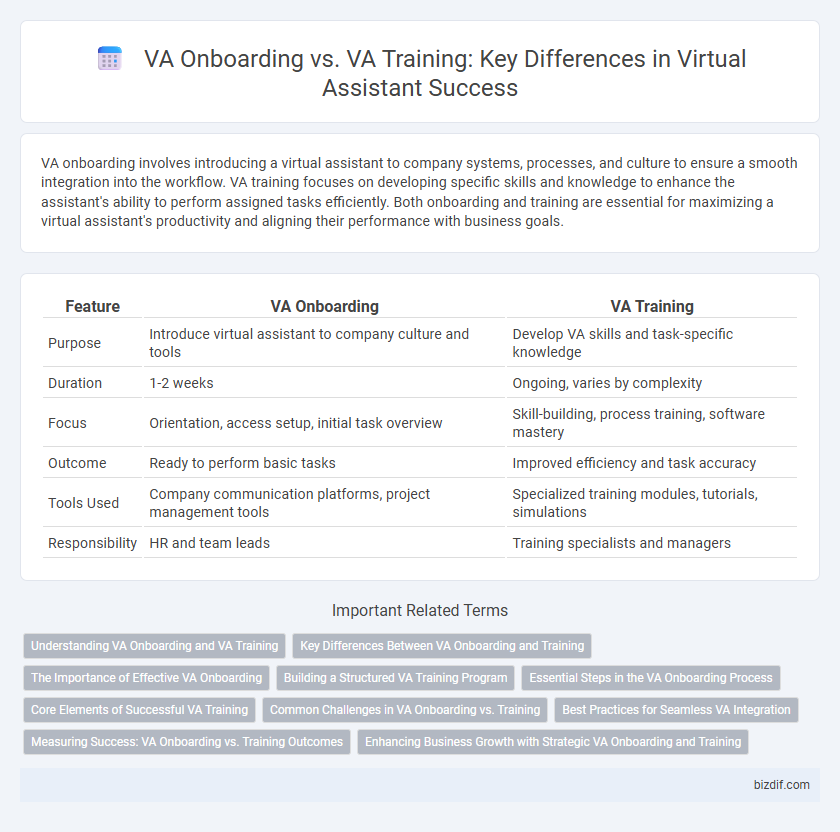VA onboarding involves introducing a virtual assistant to company systems, processes, and culture to ensure a smooth integration into the workflow. VA training focuses on developing specific skills and knowledge to enhance the assistant's ability to perform assigned tasks efficiently. Both onboarding and training are essential for maximizing a virtual assistant's productivity and aligning their performance with business goals.
Table of Comparison
| Feature | VA Onboarding | VA Training |
|---|---|---|
| Purpose | Introduce virtual assistant to company culture and tools | Develop VA skills and task-specific knowledge |
| Duration | 1-2 weeks | Ongoing, varies by complexity |
| Focus | Orientation, access setup, initial task overview | Skill-building, process training, software mastery |
| Outcome | Ready to perform basic tasks | Improved efficiency and task accuracy |
| Tools Used | Company communication platforms, project management tools | Specialized training modules, tutorials, simulations |
| Responsibility | HR and team leads | Training specialists and managers |
Understanding VA Onboarding and VA Training
VA onboarding focuses on integrating new virtual assistants into the company culture by introducing them to workflows, tools, and communication protocols. VA training centers on developing specific skills and competencies required for tasks such as calendar management, customer support, and data entry. Efficient onboarding ensures a smooth transition, while targeted training enhances performance and productivity in virtual assistant roles.
Key Differences Between VA Onboarding and Training
VA onboarding involves integrating a virtual assistant into company systems, defining roles, and setting expectations, while VA training focuses on skill development, task-specific instruction, and performance improvement. Onboarding typically covers administrative tasks and tool familiarization, whereas training emphasizes continuous learning and competency building in areas such as customer service, software usage, and communication protocols. Understanding these distinctions ensures streamlined VA adoption and maximizes productivity.
The Importance of Effective VA Onboarding
Effective VA onboarding is crucial for integrating virtual assistants swiftly into company workflows, ensuring clear communication of roles, expectations, and tools from the start. Proper onboarding reduces ramp-up time, enhances productivity, and fosters a strong working relationship, which is essential before any specialized VA training begins. Investing in structured onboarding protocols accelerates VA alignment with business goals and maximizes long-term performance outcomes.
Building a Structured VA Training Program
Building a structured VA training program ensures virtual assistants develop core competencies aligned with business goals, promoting efficiency and consistency in task execution. Onboarding introduces basic tools and company culture, while training emphasizes skill development, workflow mastery, and ongoing performance improvement. A comprehensive approach integrates clear learning objectives, hands-on practice, and regular feedback to optimize VA productivity and job satisfaction.
Essential Steps in the VA Onboarding Process
Effective VA onboarding includes setting clear expectations, providing detailed role-specific resources, and establishing communication protocols to ensure smooth integration. Structured onboarding accelerates the virtual assistant's understanding of company culture and workflow, resulting in higher productivity. Prioritizing these essential steps reduces time-to-competency and improves long-term collaboration.
Core Elements of Successful VA Training
Effective VA training centers on clear communication of roles, tailored skill development, and ongoing performance feedback. Core elements include comprehensive onboarding materials, hands-on practice with the relevant tools, and structured mentorship programs. This focused approach ensures virtual assistants quickly adapt and maintain high productivity levels.
Common Challenges in VA Onboarding vs. Training
Virtual assistant onboarding often encounters challenges such as unclear role definitions and insufficient access to necessary tools, which can delay productivity. VA training faces obstacles like varying skill levels and the need for continuous content updates to keep pace with evolving technologies. Addressing these issues requires streamlined communication channels and tailored learning modules to enhance efficiency and competence.
Best Practices for Seamless VA Integration
Effective VA onboarding establishes clear expectations, introduces essential tools, and aligns goals to accelerate productivity. Comprehensive VA training focuses on skill development, process familiarization, and continuous feedback to enhance performance. Combining structured onboarding with targeted training ensures seamless VA integration and maximizes long-term collaboration success.
Measuring Success: VA Onboarding vs. Training Outcomes
Measuring success in VA onboarding focuses on how quickly a virtual assistant adapts to company-specific tools, processes, and culture, ensuring efficient task execution from the start. In contrast, VA training outcomes emphasize skill enhancement, knowledge acquisition, and the assistant's ability to handle more complex responsibilities over time. Comparing key performance indicators (KPIs) such as task accuracy, response time, and overall productivity helps determine the effectiveness of both onboarding and training phases.
Enhancing Business Growth with Strategic VA Onboarding and Training
Strategic VA onboarding establishes clear expectations and integrates virtual assistants seamlessly into business operations, accelerating productivity and reducing ramp-up time. Comprehensive VA training equips assistants with specialized skills to handle complex tasks, increasing efficiency and supporting scalable growth. Combining targeted onboarding with ongoing training enhances performance, driving sustained business growth and competitive advantage.
VA onboarding vs VA training Infographic

 bizdif.com
bizdif.com